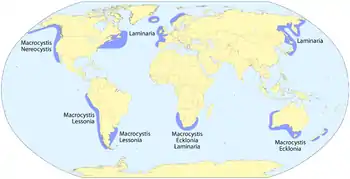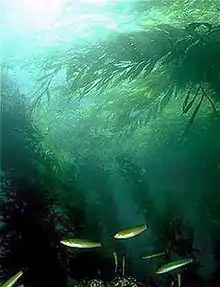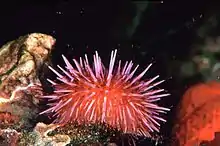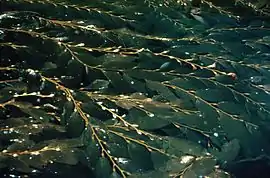海藻林
海藻林是由海帶目()大型褐藻所構成的海底森林,為最富有豐富生產力與多樣性的地球生態系統。[1]較小片的海藻林又被稱為海藻床。

全球海藻林分布
| 海洋生物栖息地 |
|---|
 海藻林 |
海藻林分布於溫帶到極地地區的沿岸海域。[1]在2007年,於厄瓜多附近的熱帶海域也發現有海藻林分佈。[2] 和熱帶的珊瑚礁一樣,海藻林為許多生物提供生活環境,包括軟體動物、甲殼動物、棘皮動物、魚類及海洋哺乳動物等;同時也為人類提供生產力豐富的漁場。
然而,人類活動正逐漸影響海藻林的分佈。針對某些物種的過度捕撈會使得部分草食動物(例如:海膽、褐藍子魚)的數量失控,進而將海藻啃食殆盡。[3]當海藻消失後,荒蕪地帶將無法供養多少生命。[4][5]設立海洋保護區能有效緩和這個狀況的發生。
海藻
海藻林的主要由不等鞭毛類海帶目的巨型海藻構成,最常見者為大浮藻屬[6],其他成員也包括海帶屬、搗布屬[7]、巨藻屬、大裙帶菜屬[8]、黑菜屬[9]。
許多生物,包括魚類,利用海藻林作為棲息地以及食物來源。例如:平鮋科、端足類、蝦、海螺、多毛綱、陽遂足等;也包括一些海生哺乳動物與鳥類,例如:海獺、鷗、燕鷗、雪鷺、大藍鷺與鸕鶿等[10]。
海藻屬於原生生物而非植物,由葉狀體組成,不具有葉片、根系和莖,但具有功能類似的結構[4]:
- 固著器是類似根系的構造,將整株海藻固著於海床上,但不具有吸收營養的功能。
- 柄是類似莖的構造,負責連結海藻的各種結構。
- 藻體是類似植物葉片的構造,負責吸收營養以及行光合作用。
此外,許多海藻的藻體與柄之間具有浮球組織,可以提供浮力,幫助它們在水流中維持直立。
海藻生存的條件包括堅實的海床沉積(岩石或沙)、大量的營養鹽(氮或磷)與充足的光線(每年最低輻照度 > 50 E m−2[11])。海藻林多半仰賴上升流帶來較低溫且富含營養物質的海水滋養[11]。在理想情況下,大浮藻屬一天可成長 30–60 公分。腔囊藻屬為一年生,黑菜屬則為多年生,壽命可超過 20 年[12]。
圖集
參考文獻
- Mann, K.H. 1973. Seaweeds: their productivity and strategy for growth. Science 182: 975-981.
- Graham, M.H., B.P. Kinlan, L.D. Druehl, L.E. Garske, and S. Banks. 2007. Deep-water kelp refugia as potential hotspots of tropical marine diversity and productivity. Proceedings of the National Academy of Sciences 104: 16576-16580.
- Sala, E., C.F. Bourdouresque and M. Harmelin-Vivien. 1998. Fishing, trophic cascades, and the structure of algal assemblages: evaluation of an old but untested paradigm. Oikos 82: 425-439.
- Dayton, P.K. 1985a. Ecology of kelp communities. Annual Review of Ecology and Systematics 16: 215-245.
- Norderhaug, K.M., Christie, H., 2009. Sea urchin grazing and kelp re-vegetation in the NE Atlantic. Marine Biology Research 5, 515-528
- 國家教育研究院雙語詞彙、學術名詞暨辭書資訊網
- 國家教育研究院雙語詞彙、學術名詞暨辭書資訊網
- 國家教育研究院雙語詞彙、學術名詞暨辭書資訊網
- 國家教育研究院雙語詞彙、學術名詞暨辭書資訊網
- Kelp forests provide habitat for a variety of invertebrates, fish, marine mammals, and birds 页面存档备份,存于 NOAA. Updated 11 January 2013. Retrieved 15 January 2014.
- Druehl, L.D. 1981. The distribution of Laminariales in the North Pacific with reference to environmental influences. Proceedings of the International Congress on Systematic Evolution and Biology 2: 248-256.
- Steneck, R.S. and M.N. Dethier. 1994. A functional group approach to the structure of algal-dominated communities. Oikos 69: 476-498.
This article is issued from Wikipedia. The text is licensed under Creative Commons - Attribution - Sharealike. Additional terms may apply for the media files.


.jpg.webp)





